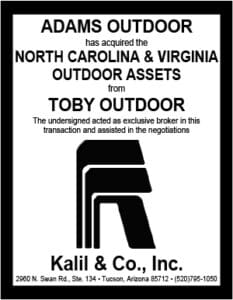
Virtually every State requires that the operator demonstrate private access for the erection and maintenance of his billboard. The Texas Department of Transportation, for example, states in 43 Texas Administrative Code Section 21.199(a)(2) that it is a ground for cancellation of the permit if the billboard is maintained from the public right of way, instead of from private property as required in the permit.
Given the importance of private access in the billboard industry, the Texas Supreme Court’s February 16, 2024 decision in Albert vs Fort Worth & Western RR Co. on “prescriptive easements” is especially interesting and relevant. In short, Albert and his partner, Chisholm Trail Redi-Mix, bought land adjacent to Western’s railroad crossing, for the purpose of building and operating a concrete plant. The seller of the property, Meek, had been crossing the railroad tracks by a gravel road for decades, but with only doubtful formal written permission to do so. When Albert started crossing the railroad tracks by the same gravel road, Western threatened to sue for trespass. But, Albert sued first, for a declaration that it held an “easement by estoppel, and easement by necessity, and a prescriptive easement” to cross Western’s railroad tracks. The jury ruled in Albert’s favor, finding all three types of easements had been established. The court of appeals reversed, ruling that Albert was liable to Western for trespass as the elements of easement were not demonstrated.
The Texas Supreme Court then reversed, holding the evidence was “sufficient to support the jury’s finding that Albert is ‘entitled to a prescriptive easement for use of the railroad crossing.’” In doing so, the Court explained that an “easement by prescription is established by the open, notorious, hostile, adverse, uninterrupted, exclusive and continuous use of the railroad crossing for a period of more that 10 years, by Albert and his predecessors in title.” The Court went on to say that “the adverse use necessary to establish a prescriptive easement is the same adversity of use necessary to establish title by adverse possession.” Here, the facts that Albert and Meek before him used the gravel road to cross the railroad tracts for some five decades without complaint, and that aerial photographs and surveys openly demonstrated that use, sufficiently qualified under the test.
Like Albert in this case, the operator unfortunately but occasionally finds that critical access for the maintenance of his billboard over the private leasehold premises is not clearly articulated in the lease. Of course, expressly providing for such access and ingress to erect, maintain, change copy, and otherwise operate the billboard is one of the most important provisions to incorporate into the lease. But, when the lease is not that clear, or because of subsequent changes in the use or owners of the land that eliminated it, securing private access through a prescriptive easement may be the next best alternative. Typical facts supporting the establishment of a prescriptive easement in the billboard context may include the construction and use of a road to the sign over the leasehold premises, for several years without complaints, and perhaps even fencing or otherwise excluding others from interfering with such access.
These are tough cases, so once again, get it right the first time and provide for private access in the lease. But, if not, get a good lawyer, and Good Luck!
To receive a free morning newsletter with each day’s Billboard insider articles email info@billboardinsider.com with the word “Subscribe” in the title. Our newsletter is free and we don’t sell our subscriber list.
Paid Advertisement

















